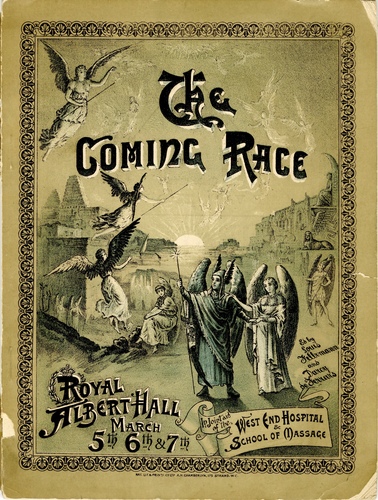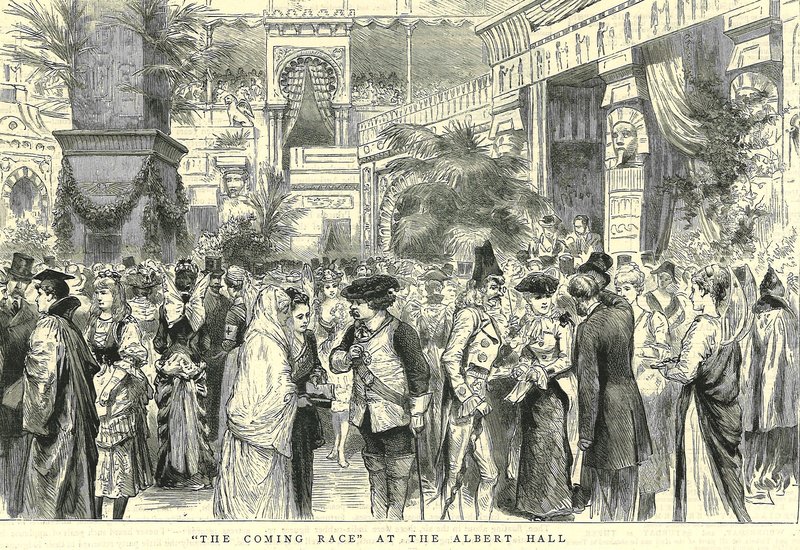Vril-Ya Bazaar And Fete on:
[Wikipedia]
[Google]
[Amazon]
 The Vril-Ya Bazaar and Fete (more fully billed as 'The Coming Race' and 'Vril-Ya' Bazaar and Fete, in joint aid of The West End Hospital, and the School of Massage and Electricity) was an event held March 5–10, 1891 at the
The Vril-Ya Bazaar and Fete (more fully billed as 'The Coming Race' and 'Vril-Ya' Bazaar and Fete, in joint aid of The West End Hospital, and the School of Massage and Electricity) was an event held March 5–10, 1891 at the
 Suspended, and sometimes moving as if flying, above the crowd were
Suspended, and sometimes moving as if flying, above the crowd were
Selected pages from the programme, courtesy of the Royal Albert Hall Archive. (Ref. RAHE/1/1891/5)
"World's First Sci-Fi Convention," Objectivity episode 184 (video about the event)
March 1891 events Events at the Royal Albert Hall Science fiction conventions in the United Kingdom Edward Bulwer-Lytton
 The Vril-Ya Bazaar and Fete (more fully billed as 'The Coming Race' and 'Vril-Ya' Bazaar and Fete, in joint aid of The West End Hospital, and the School of Massage and Electricity) was an event held March 5–10, 1891 at the
The Vril-Ya Bazaar and Fete (more fully billed as 'The Coming Race' and 'Vril-Ya' Bazaar and Fete, in joint aid of The West End Hospital, and the School of Massage and Electricity) was an event held March 5–10, 1891 at the Royal Albert Hall
The Royal Albert Hall is a concert hall on the northern edge of South Kensington, London. One of the UK's most treasured and distinctive buildings, it is held in trust for the nation and managed by a registered charity which receives no govern ...
in the British capital of London. It was organized by Herbert Tibbits to celebrate ''The Coming Race
''The Coming Race'' is a novel by Edward Bulwer-Lytton, published anonymously in 1871. It has also been published as ''Vril, the Power of the Coming Race''.
Some readers have believed the account of a superior subterranean master race and th ...
'', an 1871 science fiction novel by Edward Bulwer-Lytton
Edward George Earle Lytton Bulwer-Lytton, 1st Baron Lytton, PC (25 May 180318 January 1873) was an English writer and politician. He served as a Whig member of Parliament from 1831 to 1841 and a Conservative from 1851 to 1866. He was Secret ...
. The Royal Albert Hall and others have described the event as the world's first science fiction convention
Science fiction conventions are gatherings of fans of the speculative fiction genre, science fiction. Historically, science fiction conventions had focused primarily on literature, but the purview of many extends to such other avenues of expre ...
.
History
Tibbits was the founder of the London Massage and Galvanic Hospital, and the Vril-Ya Bazaar was one of a number of events he had produced as fundraisers for the hospital. For each, Tibbits recruited wealthy and socially prominent individuals as a host committee for the event. For the 1891 event, Tibbits chose as the theme the world created by Bulwer-Lytton in ''The Coming Race''. The novel features a subterranean race of winged superhuman beings, the "Vril-ya", withtelepathic
Telepathy () is the purported vicarious transmission of information from one person's mind to another's without using any known human sensory channels or physical interaction. The term was first coined in 1882 by the classical scholar Frederic ...
and other parapsychological abilities who wield vast power derived from "Vril", a mysterious form of energy that the Vril-ya are able to control through their miraculous skills. In the years following its publication, the novel had achieved widespread popularity, and some occultists claimed that Bulwer-Lytton had based his novel on an actual secret race that had mastered a limitless energy source.
Tibbits' fundraising event sought to exploit the popularity of the novel. Bulwer-Lytton had described the architecture of the underground Vril-ya city as resembling the architecture of ancient Egypt
Egypt ( ar, مصر , ), officially the Arab Republic of Egypt, is a transcontinental country spanning the northeast corner of Africa and southwest corner of Asia via a land bridge formed by the Sinai Peninsula. It is bordered by the Mediter ...
, Sumeria
Sumer () is the earliest known civilization in the historical region of southern Mesopotamia (south-central Iraq), emerging during the Chalcolithic and early Bronze Ages between the sixth and fifth millennium BC. It is one of the cradles of c ...
, and India
India, officially the Republic of India (Hindi: ), is a country in South Asia. It is the seventh-largest country by area, the second-most populous country, and the most populous democracy in the world. Bounded by the Indian Ocean on the so ...
, and Tibbits had the Royal Albert Hall decorated with Egyptian artistic motifs, including a grand Pillar of Vril-ya, modeled on Cleopatra's Needle
Cleopatra's Needles are a separated pair of ancient Egyptian obelisks now in London and New York City. The obelisks were originally made in Heliopolis (modern Cairo) during the New Kingdom period, inscribed by the 18th dynasty pharaoh Thutmose I ...
.  Suspended, and sometimes moving as if flying, above the crowd were
Suspended, and sometimes moving as if flying, above the crowd were mannequin
A mannequin (also called a dummy, lay figure, or dress form) is a doll, often articulated, used by artists, tailors, dressmakers, window dressers and others, especially to display or fit clothing and show off different fabrics and textiles. P ...
s costumed as the winged Vril-ya. Entertainments were presented that sought to evoke the mystical powers of the Vril-ya, with magic shows and a fortune-telling dog. Booths offered various products and handcrafts for sale, including Bovril
Bovril is the trademarked name of a thick and salty meat extract paste similar to a yeast extract, developed in the 1870s by John Lawson Johnston. It is sold in a distinctive bulbous jar, and as cubes and granules. Bovril is owned and distrib ...
, a meat extract that had been named, in part, for Vril power in ''The Coming Race''.
The event featured a young woman depicting Princess Zee, the heroine of the novel, who wore a black satin dress and tiara that featured electric lights. Words from Bulwer-Lytton's invented Vril language were used to describe features of the event, and attendees were provided with a brochure that included a Vril glossary to help them decipher the language.
Guests were encouraged to wear costumes, and event organizers directed them to the firm John Simmons and Sons, historical costumiers to Queen Victoria
Victoria (Alexandrina Victoria; 24 May 1819 – 22 January 1901) was Queen of the United Kingdom of Great Britain and Ireland from 20 June 1837 until her death in 1901. Her reign of 63 years and 216 days was longer than that of any previo ...
, to view an array of ''Coming Race'' costumes, many sporting wings. The volunteer committee members wore various exotic costumes from a range of cultures and eras.
The youngest child of Queen Victoria, Princess Beatrice
Princess Beatrice, Mrs Edoardo Mapelli Mozzi (Beatrice Elizabeth Mary; born 8 August 1988) is a member of the British royal family. She is the elder daughter of Prince Andrew, Duke of York, and Sarah, Duchess of York. She is a niece of Charle ...
and her husband Prince Henry of Battenberg
Prince Henry of Battenberg (Henry Maurice; 5 October 1858 – 20 January 1896) was a morganatic descendant of the Grand Ducal House of Hesse. He became a member of the British royal family by marriage to Princess Beatrice of the United Kingdo ...
attended on the first day to officially open the event. The host committee that Tibbits recruited to help organize the event and staff the stalls included the Marchioness Dowager of Londonderry, the Countess of Cromarty and Lady Georgiana Spencer Churchill.
Reception
The event was originally scheduled to run for only three days, but the organizers extended it for an additional two days, "due to popular demand". However, reviews of the event were unfavorable. Newspapers criticized decorations as badly constructed and shabby. A reviewer in the ''Leeds Times
The ''Leeds Times'' was a weekly newspaper established in 1833, and published at the office in Briggate, Leeds, West Yorkshire, England
England is a country that is part of the United Kingdom. It shares land borders with Wales to its w ...
'' called it "a very sorry affair, inartistic, stupid ... a vulgar entertainment in the name of charity". Despite the extended run, the event was a financial failure. Tibbits had covered the costs associated with holding the event from his own funds, and the failure of the event to bring in expected revenues bankrupted him.
References
{{ReflistExternal links
Selected pages from the programme, courtesy of the Royal Albert Hall Archive. (Ref. RAHE/1/1891/5)
"World's First Sci-Fi Convention," Objectivity episode 184 (video about the event)
March 1891 events Events at the Royal Albert Hall Science fiction conventions in the United Kingdom Edward Bulwer-Lytton